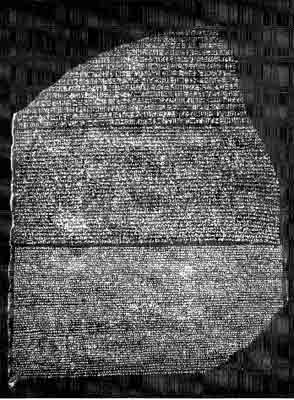
TRACING THE SCRIPT AND THE LANGUAGE OF THE ANCIENT MACEDONIANS
According to the perception of contemporary science, as well as the text being written in three scripts, two languages had been used:
ancient Egyptian (written with hieroglyphs and in the demotic script)
ancient Greek (written in ancient Greek script)
A basic assumption of our research is that in writing the text on the Rosetta Stone three scripts were used, but in three languages: ancient Egyptian, written in the hieroglyphic script, ancient Macedonian, written in the demotic script, and ancient Greek written in the ancient Greek alphabet. It should be mentioned that one of the most significant and leading works in the field of study of the demotic script as well as the language, the new Egyptian language as it is called, is the Dictionary and Grammar of the Demotic Language, The Oriental Institute of Chicago, USA. Although it is clear and generally accepted that a syllabic script is in question, in this significant publication the authors point out that they are not capable being read sign by sign (syllable after syllable), but they suggest the text is written word after word, and at the same time supposing an absolute language identity in the forming of sentences, phrases and all the names of rulers and gods in the text in ancient Egyptian with the ancient Greek text.
The appearances of the three parts of the text are available on the following links: hieroglyphic, demotic, ancient Greek.
The perceptions and results of our research in analyzing and deciphering the middle text of Rosetta Stone are presented here, starting from the assumption that the text in the demotic script was written in the language of the ancient Macedonians, i.e. in the ancient Macedonian language. You may proceed to the characteristics of the analyzed script through the following topics:
- Basic characteristics of the script.
- Wiring for sound of the identified signs.
- Some rules for writing.
- Mentioning the name of the emperor (pharaoh).
- Mentioning the names of the emperor's (pharaoh's) ancestors.
- Categories of young maids.
- Categories of priests.
- Deciphering the last line of the text.
- Names of territories and peoples.
- Names of the gods and their functions.
- Conclusion.
Click here to proceed to the dictionary of deciphered words and terms from the middle text of the Rosetta Stone.
Click here to proceed to the complete text.
Contact:
Aristotel Tentov Оваа е-адреса е заштитена од спамботови. Треба да ви е овозможено JavaScript за да ја видите.
Tome Bosevski
 The Rosetta Stone is one of the best known textual artifacts from ancient Egypt, object of a great number of studies and much research in the scholarly world of this field. It has its name because the location where it was excavated, that is Rosetta, i.e. El-Rashid in Arabic. It was discovered by a French soldier who had been working on excavating fortifications for the needs of Napoleon's army during his campaign in Egypt in the year 1799.
The Rosetta Stone is one of the best known textual artifacts from ancient Egypt, object of a great number of studies and much research in the scholarly world of this field. It has its name because the location where it was excavated, that is Rosetta, i.e. El-Rashid in Arabic. It was discovered by a French soldier who had been working on excavating fortifications for the needs of Napoleon's army during his campaign in Egypt in the year 1799.
After a short military clash with the English army, when Napoleon won the battle, a peace treaty was signed in Alexandria in 1802. In accordance with the regulations of this peace treaty all the goods and artifacts possessed by the French army became the property of the British. On the basis of this, the Rosetta Stone was moved to England where it still is today and is one of the best-known exhibits at the British Museum in London. The Rosetta Stone is a stone of black granite, characterized with the following attributes
height 1.44m
width 0.72m
thickness 0.28m
weight 762kg
The special decree that had been inscribed on it, according to contemporary scholarship, was issued by the priests in order to glorify the pharaoh Ptolemy V Epiphany Eucharist one year after his coronation, more precisely, according to present-day calendar on 27th of March 196 B.C.
http://rosetta-stone.etf.ukim.edu.mk/
